The Triennial, the most ambitious event mounted by the National Gallery of Victoria and one of the most exciting exhibitions ever mounted in Australia, is a serious, intelligent exhibition that assumes globalisation as fact, and examines its consequences. Many pieces are focused on the movement of people, particularly refugees; still more deal with technology, wealth, inequality and the rise of China. It is an unflinching exploration of the modern world.
The issues are big but, at first blush, the Triennial is playful, with endless opportunities for Instagram or selfies. It’s OK to take your picture here – no judgment. On the ground floor, where the cafe usually is, there’s a full-sized replica Moroccan tea house, designed by Hassan Hajjaj, including a photo booth. On the same floor, Yayoi Kusama’s Flower Obsession is an entire apartment outfitted by Ikea, where visitors are given a sticker of a red flower and told to place it where they like. Eventually, across the four months of the exhibition, the flowers will cover all of it.
On the day of our visit, that apartment was filled with delighted children who thrilled at the immersive nature of Kusama’s space, along with many other sites of the exhibition that demand to be touched (or at least smelt).
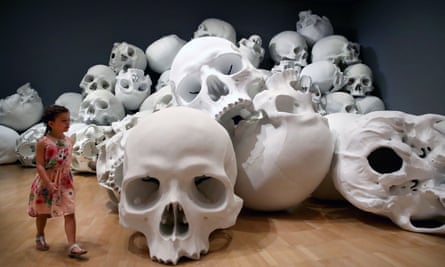
More than 100 artists and designers from 32 countries are involved in the NGV’s inaugural art and design Triennial. Taking place across all floors of the gallery, it’s more than just a free summer blockbuster; it features architecture, animation, performance art, film, virtual reality, tapestry, fashion design, design and sculpture. And somehow, there’s not a single underwhelming or boring work included.
One of the first things visitors will see is a giant reclining Buddha created by the Chinese artist Xu Zhen; like many of the works on show, it is both playful and profound.
At 18 metres long, Eternity-Buddha in Nirvana is the largest work in Xu’s Eternal series and is one of 20 large-scale artworks commissioned by the NGV for the Triennial. It took months to ship its parts from China to assemble in the gallery’s foyer. The massive Buddha is draped by classical nude sculptures, in an east-meets-west melange.
Also on the ground floor is the wonderful and weird work by the chemist and Norwegian artist Sissel Tolaas, whose medium is smells. Last year Tolaas visited Melbourne to collect scents – past and present, nasty and nice – before returning with her rub-and-sniff collection.
With a platinum bob and bright lipstick, Tolaas is standing near the panels of smells, and delights in observing the reactions of patrons. You really don’t know what the smell will be until you stick your nose on it. Some of it smells like old cheese, others of backyard dunny, a peat fire or the banks of the Yarra on a hot day.
“Oh God, they’re not, like, nice smells; they’re really gross,” one patron says.
Toolas explains that she collected the smells of Melbourne last year and had them turned into chemicals, which are embedded in the panels along the NGV’s walls.
“These smells will last seven years,” she says. “So much information about people and the city are in these smells.”
Like the smells themselves, you will need to visit the Triennial more than once to take in the breadth of talent on display. Some of the pieces are so commanding that they require more than one visit to mentally process them; and common threads between the works take some working out.
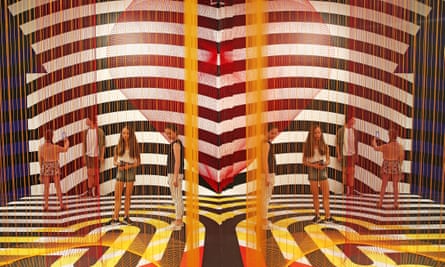
On Guardian Australia’s second visit to the Triennial, beyond the playful, colourful, technologically advanced and Instagrammable work a more distressed picture emerged.
The Triennial hints at a world on the point of collapse, where old power structures are falling and new ones emerging.
The layout is disorientating – maybe deliberately so. So at one point you are marvelling at the Fantasia-style gowns of Chinese couturier Guo Pei, who designed singer Rihanna’s canary yellow Met Ball gown (she is the first Asian-born fashion designer to be included in the French haute syndicate); then you walk down a ramp and into a room, where the arresting video work of Richard Mosse is on show.
A word on this: Mosse’s work, Incoming – an NGV co-commission – is a standout in a show of incredibly high caliber.
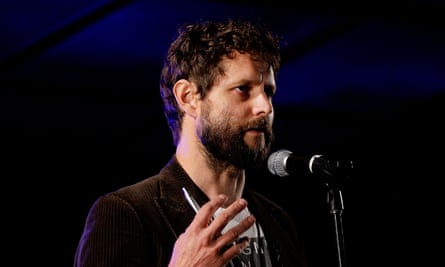
Incoming runs for more than 50 minutes on three screens and shows the refugee experience in a way that collapses borders between journalism and art.
Mosse, an Irish-born, New York based photographer, working with the cinematographer Trevor Tweeten, uses military grade technology to capture thermal images of refugees’ journeys – including footage from boats, from the “jungle” camps at Calais and from a hospital morgue.
“It can detect body heat from 30.3km, so it’s a unique technology,” Mosse told Guardian Australia. The camera is defined as a weapon under international law, as it’s a piece of technology used for long-range surveillance, capturing positions of jihadists in places like Syria.
“With this camera you can’t get the wide angle – its telescopic, which initially was limiting,” Mosse says.
But it is in this telescopic focus that the work takes on its extraordinary power. This power is not just in images but texture; it’s found in the hot hands of the doctors, removing white cold tissue and bone from the decomposed corpses of children in a field hospital.
One of the themes of the Triennial is movement. Movement of people is one of the defining political and social stories of our age – and that story is told here in a variety of mediums.
A series of passport-like photos of figures wearing African masks by Angolan artist Edson Chagas highlights issues of migration and movement of refugees, while South African artist Candice Breitz tells the personal histories of six refugees via video work featuring Julianne Moore and Alec Baldwin.
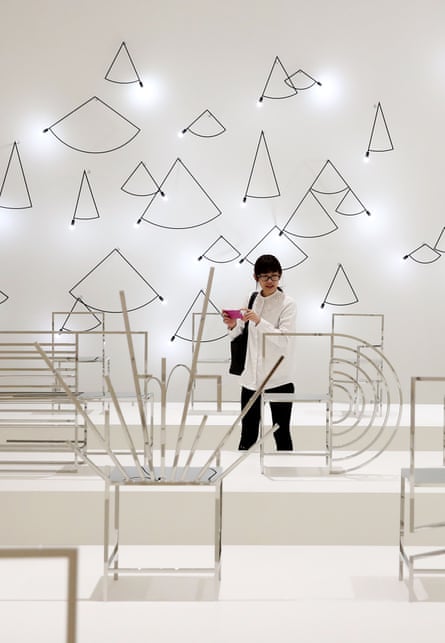
Australia’s Ben Quilty’s stark and important work is also on display. The NGV is showing one of his paintings – a small orange lifejacket, representing one of the thousands of refugees who have died making the journey to our shores from their homelands.
At the media preview on Friday, Quilty told Guardian Australia of the sea of lifejackets that he and writer Richard Flanagan saw washed up on the beach at Lesbos.
“We’re in the middle of the world’s largest refugee crisis – and look at Australia’s response,” Quilty said. “Look at Peter Dutton, it’s a disgrace. You have to teach empathy and compassion – and a great place to do that is a gallery or museum, where you have all these children coming through.”
Another consequence of globalisation represented amongst the work is environmental degradation. Brodie Neill’s Gyro table is comprised of bits of micro plastic that get stuck in the guts of fish; and PetLamp from Spain combines old bottles and other refuse with ancient crafts. PetLamp’s collaboration with women weavers from Arnhem Land in northern Australia is a work of gorgeous design, which incorporates the womens’ family and kinship relationships within the lamps themselves, which are gorgeously reflected by mirrors from below.
While the present moment is being explored with immense energy and intelligence, the centrepiece of the exhibition brings stark, existential clarity.
Visitors come across Ron Mueck almost as if by accident. In the European collection rooms, with portraits of the long dead rich aristocrats, there is a single, enormous human skull. It looks like a portent of what is to come. And is.
Turn another corner and there is a room full of it. It takes your breath away. There are 100 oversized resin-cast skulls, each measuring 1.5 metres by 2 metres, created by Mueck in an installation called Mass.
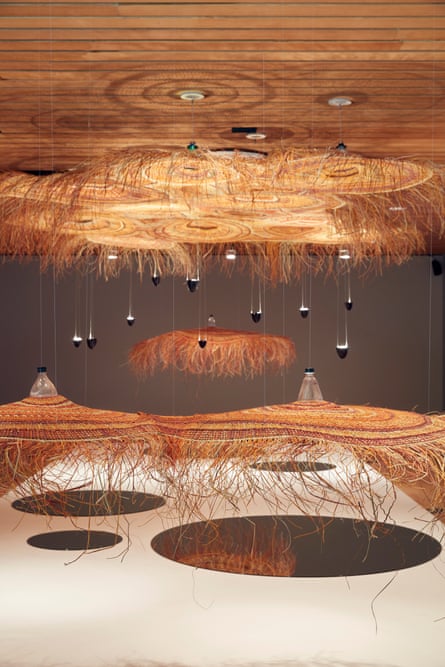
It is a work that speaks of death as the great leveller. Whether we’re dying at sea, or one of the Hollywood actors in Candice Breitz’s piece (which was renamed Wilson Must Go in protest against the NGV’s current contract with Wilson Security), or one of the nobleman on the walls – we will all end up here in the same place, and the same form: bone and ash.
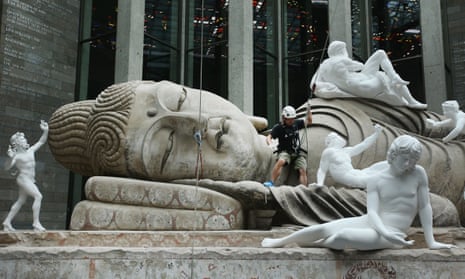
Comments (…)
Sign in or create your Guardian account to join the discussion